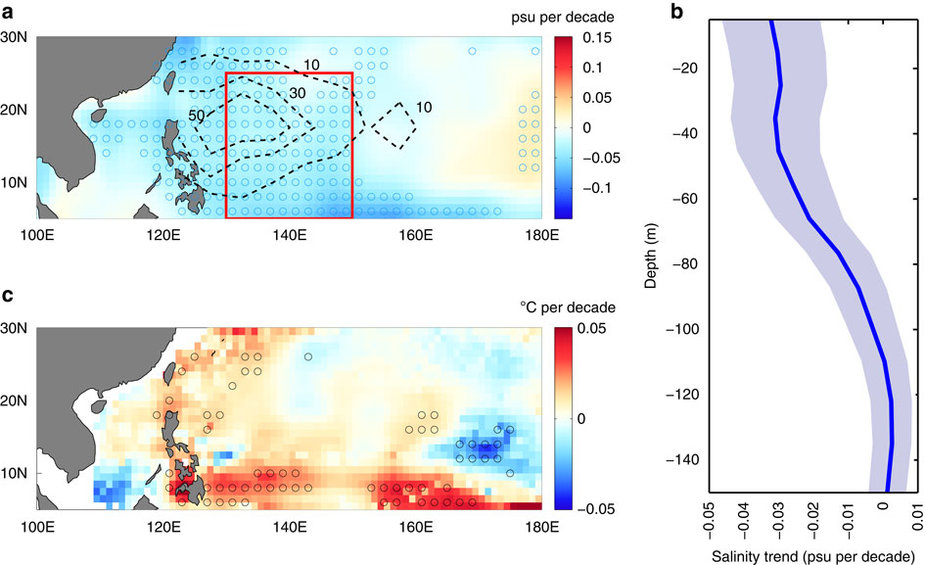Oceans and Tropical Cyclone Activity
PI: Gregory Foltz
Collaborator: Karthik Balaguru
Tropical cyclones (TCs) are one of the most destructive and widespread natural hazards in the tropics and subtropics, with considerable socio-economic impact. Theory shows that the maximum wind speed that can be achieved by a TC depends critically on the air-sea temperature difference, making sea surface temperature (SST) one of the most important parameters to affect TC intensity. It is also known that the SST cooling induced by a TC, known as its "cold wake," can act to decrease the storm's intensity by reducing the transfer of heat from the ocean to the atmosphere.
We use observations and models to (1) explore variations of TC activity on daily to multidecadal timescales and the oceanic and atmospheric conditions that drive them, and (2) improve our understanding of how upper-ocean temperature and salinity stratification affect TCs' cold wakes and intensification.

Caption (a) Trends in typhoon-season (June-November) mean sea surface salinity in psu per decade with dashed-black contours, at intervals of 20 units, overlaid representing the number of 6 hourly super typhoon (STY) track locations. The box in red indicates the study region: 130E-150E and 5N-25N. (b) Trends in typhoon- season mean subsurface salinity, averaged over the region 130E-150E and 5N-25N (see box in a), in psu per decade. The line represents the median trend value and the shaded area indicates the 95% confidence intervals, estimated using a linear regression. (c) Trends in typhoon-season (June-Nov) mean salinity contribution to cold wakes in C per decade. In a,c, locations with statistically significant trends are marked with circles.
Publications
Balaguru, K., G. R. Foltz, and L. R. Leung, 2018: Increasing magnitude of hurricane rapid intensification in the central and eastern tropical Atlantic. Geophys. Res. Lett., 45, doi:10.1029/2018GL077597.
Balaguru, K., G. R. Foltz, L. R. Leung, S. Hagos, and D. R. Judi, 2018: On the use of ocean dynamic temperature for hurricane intensity forecasting. Wea. Forecasting, 33, 411-418, doi:10.1175/WAF-D-17-0143.1.
Foltz, G. R., K. Balaguru, and S. Hagos, 2018: Interbasin differences in the relationship between SST and tropical cyclone intensification. Mon. Wea. Rev., 146, 853-870, doi:10.1175/MWR-D-17-0155.1.
Balaguru, K., G. R. Foltz, L. R. Leung, and K. A. Emanuel, 2016: Global warming-induced upper-ocean freshening and the intensification of super typhoons. Nature Comm., 7, 13670, doi:10.1038/ncomms13670.
Foltz, G. R., and K. Balaguru, 2016: Prolonged El Nino conditions in 2014-15 and the rapid intensification of Hurricane Patricia in the eastern Pacific. Geophys. Res. Lett., 43, doi:10.1002/2016GL070274.
Balaguru, K., L. R. Leung, J. Lu, and G. R. Foltz, 2016: A meridional dipole in pre-monsoon Bay of Bengal tropical cyclone activity induced by ENSO. J. Geophys. Res. Atmos., 121, 6954-6968, doi:10.1002/2016JD024936.
Balaguru, K., G. R. Foltz, L. R. Leung, E. A. D'Asaro, K. A. Emanuel, H. Liu, and S. E. Zedler, 2015: Dynamic Potential Intensity: An improved representation of the ocean's impact on tropical cyclones. Geophys. Res. Lett., 42, doi:10.1002/2015GL064822.
Foltz, G. R., K. Balaguru, and L. R. Leung, 2015: A reassessment of the integrated impact of tropical cyclones on surface chlorophyll in the western subtropical North Atlantic. Geophys. Res. Lett., 42, 1158-1164, doi:10.1002/2015GL063222.
Balaguru, K., S. Taraphdar, L. R. Leung, G. R. Foltz, and J. A. Knaff, 2014: Cyclone-cyclone interactions through the ocean pathway. Geophys. Res. Lett., 41, 6855-6862, doi:10.1002/2014GL061489.
Balaguru, K., S. Taraphdar, L. R. Leung, and G. R. Foltz, 2014: Increase in the intensity of post-monsoon Bay of Bengal tropical cyclones. Geophys. Res. Lett., 41, 3594-3601, doi:10.1002/2014GL060197.
Wang, C., S. Dong, A. T. Evan, G.R. Foltz, and S.-K. Lee, 2012: Multidecadal covariability of North Atlantic sea surface temperature, African dust, Sahel rainfall and Atlantic hurricanes. Journal of Climate, 25, 5404-5414, doi:10.1175/JCLI-D-11-00413.1.